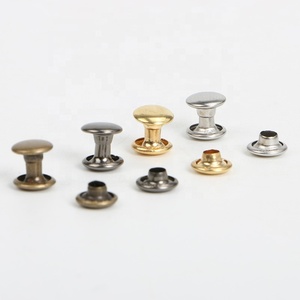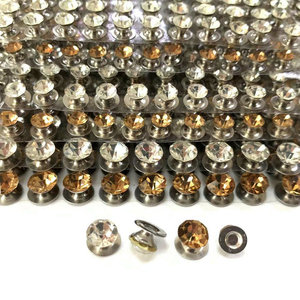(3345 products available)





































































































































































































4mm rivets are widely used in construction and mechanical applications for permanent fastening of material. They come in different forms and shapes to suit a variety of applications. Below are some of their types:
Solid Rivets
These are cylindrical metal pins with a round head on one end. The length of the rivet is equal to the thickness of the material to be fastened plus 1/8 inch. They are commonly made of steel and aluminum. The solid type is used in steel structures such as bridges and buildings. The application requires tools to deform the unheaded end into a buck-tail or shop head. The tools are hammers, pneumatic guns, or hydraulic presses. The deformation creates a permanent joint that cannot be undone.
Hollow Rivets
This type is similar to the solid 4mm rivet, but it has a hole in the center. It is lighter and easier to use than the solid type. Hollow fasteners are used in leather and thin sheet metal. They are fastened by deforming the end into a clinch or by using a mandrel to expand the inside. A mandrel inserts into the rivet's hole and expands it to form a head inside the material.
Blind Rivets
Blind fasteners are used when one end of the material is inaccessible. They are fastened with a mandrel or by pulling a pin. The mandrel inserts into the rivet and forms a head to hold the rivet in place. The rivet is also secured by expanding its body against the material. It is commonly used in aerospace applications to join aluminum and thin sheet metals. There are different types of blind fasteners, including:
Semirigid Rivets
Semirigid fasteners are similar to solid rivets but have a softer shank. Their shank is softer than the head, which is harder. The difference in hardness creates a strong joint as the shank deforms to fit the material. They are used in steel and aluminum applications.
Flat Rivets
These are cylindrical pins with a flat head. They are used in leather and thin sheet metal. Flat fasteners are easier to use and require simple tools. They are fastened by driving them into the material and forming a small hole.
The design of 4mm rivets can be diverse and tailored to meet specific requirements and applications. Here are some key design aspects when using a 4 mm rivet, particularly for small-scale applications:
Head Design
The head of a 4 mm rivet is usually slightly larger than the shank to provide a bearing surface. It can be flat or domed, depending on the application. A flat head offers a low profile, while a domed head can better resist shear forces and provides a more finished appearance.
Shank and Diameter
For a 4 mm rivet, the shank diameter is 4 mm. The shank length may vary based on the material thickness being joined. It should be long enough to form a secure joint but not so long that it extends beyond the materials being fastened. The shank needs to have a uniform diameter to ensure consistent strength along its length.
Material and Strength
These small rivets are often made from stainless steel or other metals to provide adequate tensile and shear strength for small applications. Stainless steel rivets resist corrosion and are ideal for applications exposed to moisture or chemicals.
Forming the Joint
Rivet joints are formed by deforming the tail or shank of the rivet. This can be done using a hammer, pneumatic tool, or hydraulic press. The deformation creates a head or bucked tail that locks the rivet in place, forming a strong, permanent joint.
Finish and Coating
Surface finish on a 4 mm rivet can include plating, anodizing, or passivation to enhance corrosion resistance and improve appearance. Coatings like zinc or gold are common for added protection against environmental factors.
Applications
4 mm rivets are used in various applications, including electronics, automotive, and aerospace. They are well-suited for joining thin materials like metal sheets, plastics, and composites. Their small size makes them ideal for applications where space is limited, such as in electronic devices, where they secure components without adding significant weight or bulk. In automotive and aerospace applications, 4 mm rivets provide a reliable and permanent fastening solution for body panels, trim pieces, and structural components, ensuring the integrity and durability of the assembly.
4mm rivets are small fasteners used in leather and fabric work. They come in different designs and blends with specific materials to improve their functionality and aesthetics. Here are some wearing and matching suggestions for 4mm rivets:
Q1: What are some common applications of 4mm rivets?
A1: 4mm rivets are commonly used in various applications, including the assembly of metal sheets in construction, automotive, and aerospace industries. They are also utilized in leatherworking and crafting for fastening materials securely.
Q2: What materials are 4mm rivets made of?
A2: 4mm rivets are made from various materials, including aluminum, steel, and stainless steel. Aluminum rivets are lightweight and resistant to corrosion, making them suitable for aerospace applications. Steel and stainless steel rivets offer higher strength and durability, ideal for heavy-duty applications.
Q3: How are 4mm rivets installed?
A3: 4mm rivets are installed using a rivet gun or manually by hand. The rivet is placed in a pre-drilled hole, and the rivet's tail is compressed using the rivet gun, causing it to expand and form a secure joint. Alternatively, solid rivets can be installed by hammering them to achieve the same effect.
Q4: Can 4mm rivets be used for structural applications?
A4: Yes, 4mm rivets can be used for structural applications, especially when made from high-strength materials like stainless steel. They are capable of bearing significant loads and providing stable connections in structural steelwork and metal fabrication.
Q5: Are 4mm rivets removable?
A5: 4mm rivets create permanent joints, making them challenging to remove without damaging the materials they fasten. However, some blind rivets can be removed using specialized tools designed to collapse the rivet's body, allowing for disassembly without significant damage.